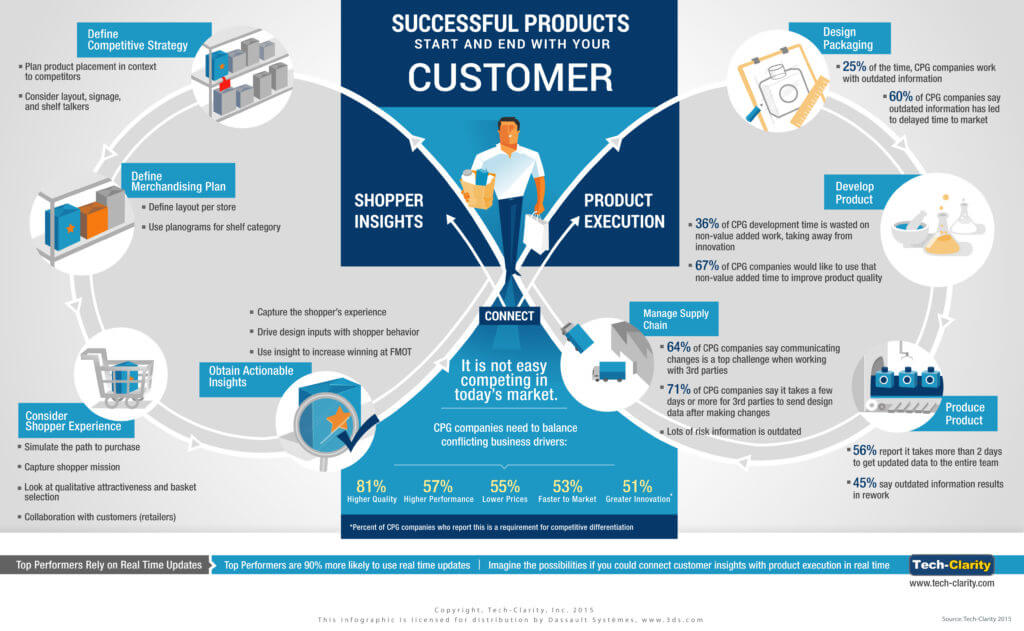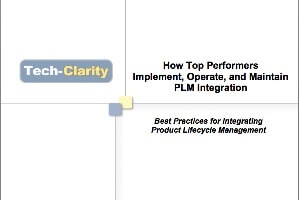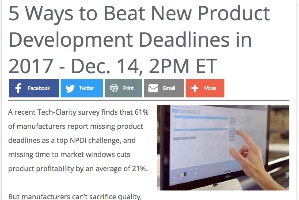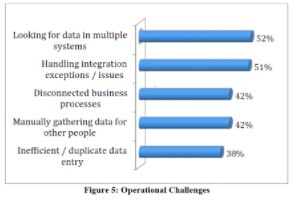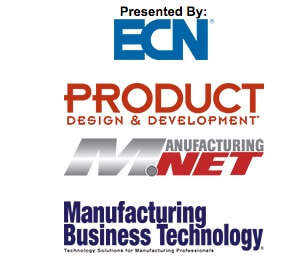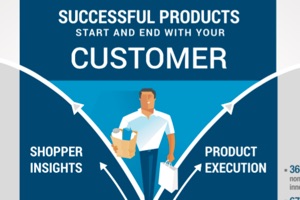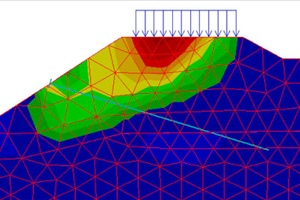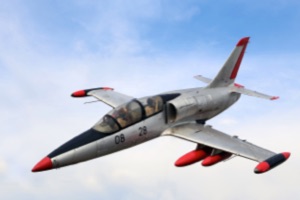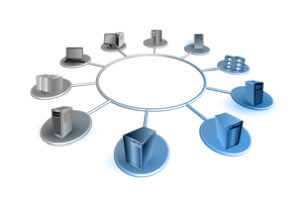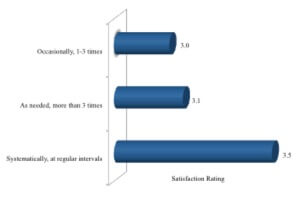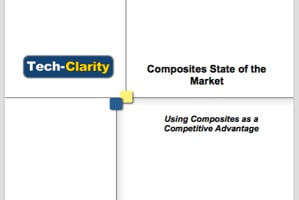How Top Performers Implement, Operate, and Maintain PLM Integration – Best Practices for Integrating Product Lifecycle Management shares survey results detailing how Top Performers implement their PLM systems. The research uncovers integration challenges and best practices across the PLM Integration Lifecycle, recognizing that implementing integration is only the first step in the process. Please enjoy…
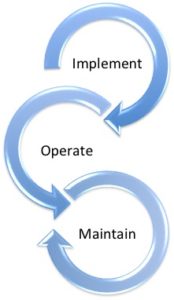 Executive Overview
Executive Overview- The Business Value of Integrating PLM
- When do Companies Begin Integrating?
- Introducing the PLM Integration Lifecycle
- Implementation Challenges
- Operation Challenges
- Maintenance Challenges
- Business Impacts
- Quantifying the Impact
- Identifying the Top Performers
- Top Performers Experience Fewer Negative Impacts
- Top Performers Integrate More
- Top Performers Integrate with More Advanced Tools
- Top Performers Integrate with More Advanced Enterprise Applications
- Top Performers Integrate More PLM Data
- Top Performers Use More Advanced Integration Techniques
- Focusing on the Future: The Impact of IoT on PLM Integration
- Conclusion
- Recommendations
- About the Author
- About the Research
- Copyright Notice
Executive Overview
Product Lifecycle Management (PLM) helps manufacturers in many ways ranging from operational efficiencies to top-line financial improvement. It improves business performance in multiple dimensions including increased revenue, reduced product cost, and decreased product development cost. But PLM is just one of many systems in the engineering and enterprise software ecosystems, and provides greater value when it shares data and connects workflows with other software. As reported in Product Lifecycle Management Beyond Managing CAD, “Top Performers are much more likely to integrate PLM with a host of other systems.” We surveyed over 150 companies to understand their PLM integration strategy, processes, and technical enablers in order to understand how proper integration can extend PLM value. The findings indicate that the vast majority of manufacturers view PLM as “Strategic” or “Important.” It also finds that many believe that PLM integration will become even more strategic (and challenging) as IoT initiatives progress. In order to understand how companies get the most business value from PLM integration, we identified manufacturers that were gaining the largest operational benefit from their PLM implementation, the Top Performers. These leaders achieve significantly better than average PLM business benefits. We analyzed what these companies do differently related to PLM integration in order to offer advice to poorer performing companies. The analysis determines that Top Performers in gaining the benefits from PLM: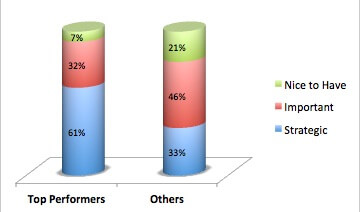 Are more likely to view PLM integration as strategic
Are more likely to view PLM integration as strategic- Integrate PLM to more design tools and more enterprise applications
- Integrate PLM to more advanced tools and applications
- Are more able to implement, operate, and maintain PLM integration in an agile, cost-effective way
- Experience fewer operational issues including:
- Needing to look for data in multiple systems
- Duplicate data entry
- Data inconsistency across systems
Conclusion
PLM helps companies improve product innovation, product development, and engineering efficiency and helps enhance communication across the enterprise and the supply chain. Improving PLM integration helps companies achieve the benefits PLM has to offer, making it a highly strategic investment. The level of importance, along with the level of complexity, will only increase as companies move to smarter, more connected products and the IoT. Top Performers, those that get the most benefits out of their PLM systems, are more likely to view PLM integration as strategic. They integrate more design tools and enterprise applications with PLM, and integrate PLM to more advanced tools and applications. They also integrate more data, including more information that spans the enterprise and the supply chain. The leads us to the conclusion that better PLM integration is simply good business. Top Performers take different approaches to integrating PLM, employing a variety of tools but more likely including adaptable techniques like a hub and spoke approach that provides benefits across the PLM Integration Lifecycle. The result is that these Top Performing companies are more able to implement, operate, and maintain PLM integration in an agile, cost-effective way and experience less need to look for data in multiple systems, perform less duplicate data entry, and find less data inconsistency across systems.Recommendations
Based on our experience and the research for this report, Tech-Clarity offers the following recommendations:- Manufacturers should integrate PLM with a broader number of enterprise applications and design tools
- Companies should integrate with more advanced systems, including those that extend beyond Engineering into the enterprise and the supply chain
- Companies should use a variety of integration techniques depending on the specific solutions and connectivity methods available, leveraging more advanced approaches such as hub and spoke when practical to provide more agility across the PLM Integration Lifecycle
- Manufacturers should consider outside expertise to fill the PLM integration knowledge gap
- Companies should focus integration plans and efforts beyond the initial implementation to optimize across the entire PLM Integration Lifecycle
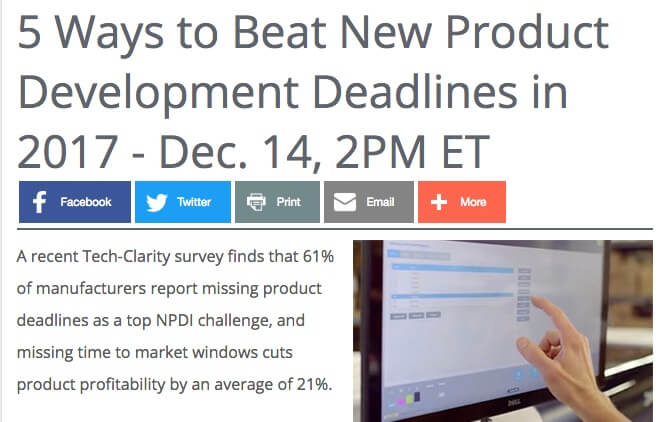 Register for the December 14 Engineering.com webcast sponsored by Autodesk (free of charge, no registration required).
[post_title] => Five Ways to Beat Product Development Deadlines (webcast)
[post_excerpt] =>
[post_status] => publish
[comment_status] => open
[ping_status] => open
[post_password] =>
[post_name] => 5-ways-beat-npd
[to_ping] =>
[pinged] =>
[post_modified] => 2022-11-14 22:26:49
[post_modified_gmt] => 2022-11-15 03:26:49
[post_content_filtered] =>
[post_parent] => 0
[guid] => http://tech-clarity.com/?p=5895
[menu_order] => 0
[post_type] => post
[post_mime_type] =>
[comment_count] => 0
[filter] => raw
)
[2] => WP_Post Object
(
[ID] => 5864
[post_author] => 2
[post_date] => 2016-11-29 09:14:31
[post_date_gmt] => 2016-11-29 14:14:31
[post_content] => Tech-Clarity analyst Jim Brown joins Razorleaf's Director of Integrations and Development Derek Neiding to share the results of a recent study on PLM integration. The webcast will highlight the strategies, processes, and technologies Top Performers use to integrate PLM with design tools and other enterprise systems.
Register now for the December 13 webcast, sponsored by Razorleaf Corporation (free of charge, registration required).
Register for the December 14 Engineering.com webcast sponsored by Autodesk (free of charge, no registration required).
[post_title] => Five Ways to Beat Product Development Deadlines (webcast)
[post_excerpt] =>
[post_status] => publish
[comment_status] => open
[ping_status] => open
[post_password] =>
[post_name] => 5-ways-beat-npd
[to_ping] =>
[pinged] =>
[post_modified] => 2022-11-14 22:26:49
[post_modified_gmt] => 2022-11-15 03:26:49
[post_content_filtered] =>
[post_parent] => 0
[guid] => http://tech-clarity.com/?p=5895
[menu_order] => 0
[post_type] => post
[post_mime_type] =>
[comment_count] => 0
[filter] => raw
)
[2] => WP_Post Object
(
[ID] => 5864
[post_author] => 2
[post_date] => 2016-11-29 09:14:31
[post_date_gmt] => 2016-11-29 14:14:31
[post_content] => Tech-Clarity analyst Jim Brown joins Razorleaf's Director of Integrations and Development Derek Neiding to share the results of a recent study on PLM integration. The webcast will highlight the strategies, processes, and technologies Top Performers use to integrate PLM with design tools and other enterprise systems.
Register now for the December 13 webcast, sponsored by Razorleaf Corporation (free of charge, registration required).
 [post_title] => Better PLM Integration Drives Better Business Performance (Webcast)
[post_excerpt] =>
[post_status] => publish
[comment_status] => open
[ping_status] => open
[post_password] =>
[post_name] => integ-webcast
[to_ping] =>
[pinged] =>
[post_modified] => 2022-11-14 22:26:45
[post_modified_gmt] => 2022-11-15 03:26:45
[post_content_filtered] =>
[post_parent] => 0
[guid] => http://tech-clarity.com/?p=5864
[menu_order] => 0
[post_type] => post
[post_mime_type] =>
[comment_count] => 0
[filter] => raw
)
[3] => WP_Post Object
(
[ID] => 5837
[post_author] => 2
[post_date] => 2016-10-25 17:53:17
[post_date_gmt] => 2016-10-25 21:53:17
[post_content] => Join an interactive discussion between Tech-Clarity's Jim Brown and Autodesk's Ron Locklin moderated by Advantage Business Media Editor in Chief Janine Mooney as they discuss the history, challenges, benefits, and future of Product Lifecycle Management (PLM). The event will be available on Product Design & Development, Manufacturing.net, and Manufacturing Business Technology.
[post_title] => Better PLM Integration Drives Better Business Performance (Webcast)
[post_excerpt] =>
[post_status] => publish
[comment_status] => open
[ping_status] => open
[post_password] =>
[post_name] => integ-webcast
[to_ping] =>
[pinged] =>
[post_modified] => 2022-11-14 22:26:45
[post_modified_gmt] => 2022-11-15 03:26:45
[post_content_filtered] =>
[post_parent] => 0
[guid] => http://tech-clarity.com/?p=5864
[menu_order] => 0
[post_type] => post
[post_mime_type] =>
[comment_count] => 0
[filter] => raw
)
[3] => WP_Post Object
(
[ID] => 5837
[post_author] => 2
[post_date] => 2016-10-25 17:53:17
[post_date_gmt] => 2016-10-25 21:53:17
[post_content] => Join an interactive discussion between Tech-Clarity's Jim Brown and Autodesk's Ron Locklin moderated by Advantage Business Media Editor in Chief Janine Mooney as they discuss the history, challenges, benefits, and future of Product Lifecycle Management (PLM). The event will be available on Product Design & Development, Manufacturing.net, and Manufacturing Business Technology.
 Watch the event live, October 31 at 12:30 PM Eastern. Sign up now (free of charge, registration required).
Sponsored by Autodesk and their Fusion Lifecycle product.
[post_title] => Engineering Live PLM Discussion
[post_excerpt] =>
[post_status] => publish
[comment_status] => open
[ping_status] => open
[post_password] =>
[post_name] => live-plm
[to_ping] =>
[pinged] =>
[post_modified] => 2022-11-14 22:26:39
[post_modified_gmt] => 2022-11-15 03:26:39
[post_content_filtered] =>
[post_parent] => 0
[guid] => http://tech-clarity.com/?p=5837
[menu_order] => 0
[post_type] => post
[post_mime_type] =>
[comment_count] => 0
[filter] => raw
)
[4] => WP_Post Object
(
[ID] => 5809
[post_author] => 2
[post_date] => 2016-10-12 09:05:03
[post_date_gmt] => 2016-10-12 13:05:03
[post_content] =>
Watch the event live, October 31 at 12:30 PM Eastern. Sign up now (free of charge, registration required).
Sponsored by Autodesk and their Fusion Lifecycle product.
[post_title] => Engineering Live PLM Discussion
[post_excerpt] =>
[post_status] => publish
[comment_status] => open
[ping_status] => open
[post_password] =>
[post_name] => live-plm
[to_ping] =>
[pinged] =>
[post_modified] => 2022-11-14 22:26:39
[post_modified_gmt] => 2022-11-15 03:26:39
[post_content_filtered] =>
[post_parent] => 0
[guid] => http://tech-clarity.com/?p=5837
[menu_order] => 0
[post_type] => post
[post_mime_type] =>
[comment_count] => 0
[filter] => raw
)
[4] => WP_Post Object
(
[ID] => 5809
[post_author] => 2
[post_date] => 2016-10-12 09:05:03
[post_date_gmt] => 2016-10-12 13:05:03
[post_content] =>  Jim Brown contributed insights from his recent research on cloud options for product innovation, product development, and engineering software in a guest post titled Moving Production Innovation and Engineering to the Cloud, What's Your Strategy? on the Siemens PLM Community. The post references findings our recent Exploring Cloud Options for Product Innovation and Development eBook.
For more information on cloud computing please visit Siemens Offers Business-ready Cloud Solutions on the Siemens site.
Jim Brown contributed insights from his recent research on cloud options for product innovation, product development, and engineering software in a guest post titled Moving Production Innovation and Engineering to the Cloud, What's Your Strategy? on the Siemens PLM Community. The post references findings our recent Exploring Cloud Options for Product Innovation and Development eBook.
For more information on cloud computing please visit Siemens Offers Business-ready Cloud Solutions on the Siemens site.
 You can also view a summary of the Exploring Cloud Options for Product Innovation and Development eBook on our site, or download the full report courtesy of Siemens PLM (free of charge, no registration required).
[post_title] => Moving Production Innovation and Engineering to the Cloud (guest blog post)
[post_excerpt] =>
[post_status] => publish
[comment_status] => open
[ping_status] => open
[post_password] =>
[post_name] => cloud-post
[to_ping] =>
[pinged] =>
[post_modified] => 2022-11-14 22:26:05
[post_modified_gmt] => 2022-11-15 03:26:05
[post_content_filtered] =>
[post_parent] => 0
[guid] => http://tech-clarity.com/?p=5809
[menu_order] => 0
[post_type] => post
[post_mime_type] =>
[comment_count] => 0
[filter] => raw
)
[5] => WP_Post Object
(
[ID] => 5820
[post_author] => 2572
[post_date] => 2016-10-11 18:55:49
[post_date_gmt] => 2016-10-11 22:55:49
[post_content] => Tech-Clarity's Infographic, Successful Products Start and End with Your Customer provides guidance to CPG companies. By embedding your customer in the middle of your product life cycle, your products will be more successful. The infographic, shows that by capturing insights obtained during the shopping experience, you can drive a move successful approach to product development.
To be successful, companies navigate multiple competing pressures. This isn't easy, but access to real time information can help. When you have real time insights into what your customers are doing in the store, you can make better product decisions for superior product execution. This essentially puts your customer at the center of your product life cycle.
For more information on this and other solutions for Consumer Product companies, please visit our sponsor Dassault Systèmes.
You can also view a summary of the Exploring Cloud Options for Product Innovation and Development eBook on our site, or download the full report courtesy of Siemens PLM (free of charge, no registration required).
[post_title] => Moving Production Innovation and Engineering to the Cloud (guest blog post)
[post_excerpt] =>
[post_status] => publish
[comment_status] => open
[ping_status] => open
[post_password] =>
[post_name] => cloud-post
[to_ping] =>
[pinged] =>
[post_modified] => 2022-11-14 22:26:05
[post_modified_gmt] => 2022-11-15 03:26:05
[post_content_filtered] =>
[post_parent] => 0
[guid] => http://tech-clarity.com/?p=5809
[menu_order] => 0
[post_type] => post
[post_mime_type] =>
[comment_count] => 0
[filter] => raw
)
[5] => WP_Post Object
(
[ID] => 5820
[post_author] => 2572
[post_date] => 2016-10-11 18:55:49
[post_date_gmt] => 2016-10-11 22:55:49
[post_content] => Tech-Clarity's Infographic, Successful Products Start and End with Your Customer provides guidance to CPG companies. By embedding your customer in the middle of your product life cycle, your products will be more successful. The infographic, shows that by capturing insights obtained during the shopping experience, you can drive a move successful approach to product development.
To be successful, companies navigate multiple competing pressures. This isn't easy, but access to real time information can help. When you have real time insights into what your customers are doing in the store, you can make better product decisions for superior product execution. This essentially puts your customer at the center of your product life cycle.
For more information on this and other solutions for Consumer Product companies, please visit our sponsor Dassault Systèmes.
 The Exploring Cloud Options for Product Innovation and Development eBook shares our thoughts about the cloud software choices available for product innovation, product development, and engineering software including PLM, PDM, CAD, CAE, and more. The eBook details the different software models available and provides considerations for each. It also helps put the various options into context with a sample flowchart on the decision to identify the appropriate deployment platform for a cloud solution, including how to consider your existing vendors' solutions in the process.
Please enjoy the summary below, or click the report or title to download the full PDF (free of charge, no registration required thanks to our sponsor, Siemens PLM).
For more information on cloud computing please visit Siemens Offers Business-ready Cloud Solutions on the Siemens site.
The Exploring Cloud Options for Product Innovation and Development eBook shares our thoughts about the cloud software choices available for product innovation, product development, and engineering software including PLM, PDM, CAD, CAE, and more. The eBook details the different software models available and provides considerations for each. It also helps put the various options into context with a sample flowchart on the decision to identify the appropriate deployment platform for a cloud solution, including how to consider your existing vendors' solutions in the process.
Please enjoy the summary below, or click the report or title to download the full PDF (free of charge, no registration required thanks to our sponsor, Siemens PLM).
For more information on cloud computing please visit Siemens Offers Business-ready Cloud Solutions on the Siemens site.
Table of Contents
- It's Time for a Cloud Strategy
- Understanding the Options *
- Comparing Your Options *
- Assessing Company Readiness *
- Sample Cloud Decision Tree *
- Reviewing Vendor Cloud Maturity *
- Special Cloud Opportunities for Product Innovation and Engineering *
- Weighing the Options, Looking at Timing *
- Next Steps
It’s Time for a Cloud Strategy
The shift toward cloud computing is undeniable. An increasing number of companies are transitioning to cloud solutions in order to take advantage of significant advantages, including:- Cost reduction
- Reduced IT resource needs
- Scalability
- Agility
- Rapid deployment
- Shifting capital investments to expenses
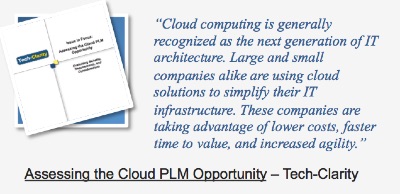 Software for product innovation, product development, and engineering – including PLM, CAD, and CAE – has evolved toward the cloud at a cautious pace. This market is closer to the beginning of the cloud transformation than some others such as CRM and ERP where cloud adoption is already more prevalent. But it’s happening. Initial skepticism is fading away and companies are learning how to effectively manage cloud software.
The market is responding with the entry of new cloud offerings and incumbents evolving to the cloud. For manufacturers planning to implement or replace product-related software, it’s time to develop a strategy that reflects the reality of today’s market. The strategy needs to consider:
Software for product innovation, product development, and engineering – including PLM, CAD, and CAE – has evolved toward the cloud at a cautious pace. This market is closer to the beginning of the cloud transformation than some others such as CRM and ERP where cloud adoption is already more prevalent. But it’s happening. Initial skepticism is fading away and companies are learning how to effectively manage cloud software.
The market is responding with the entry of new cloud offerings and incumbents evolving to the cloud. For manufacturers planning to implement or replace product-related software, it’s time to develop a strategy that reflects the reality of today’s market. The strategy needs to consider:
- Cloud delivery models
- Software capabilities and scope
- Timing and transition
Next Steps
The time is right to take advantage of the cloud, but it’s not a trivial decision or transition for product innovation, product development, and engineering software. The reality of the market maturity requires companies to develop a strategy that jointly considers vendor cloud maturity, company readiness, and the availability of needed capabilities.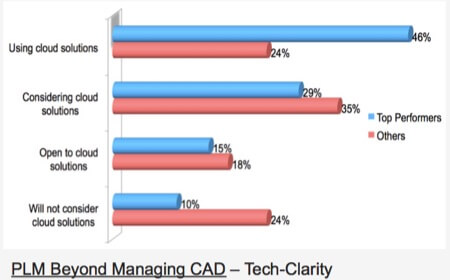 A considered cloud transition is important to reap the benefits without major disruption. Most companies are taking a very deliberate, methodical approach to leverage the cloud. For most, a staged program with a hybrid mix of solutions will be the most reasonable approach, as few companies can justify wholesale replacement of existing systems.
Fortunately, companies may not have to do it all on their own. They can adopt a pragmatic, staged approach that coordinates with their vendor’s timeline. Many existing vendors have predefined relationships with cloud services companies and trained service providers. These partnerships can provide an IaaS or managed services approach that provides benefits without having to replace existing software. In addition, many vendors offer complementary solutions that provide unique opportunities only realistically available from the cloud. It’s important to understand the potential of these solutions in your transformation strategy.
The transition to the cloud is underway. It’s time for manufacturers to take a closer look and develop a practical strategy and timeline that works for their business.
*This summary is an abbreviated version of the report and does not contain the full content. A link to download the full report is available above thanks to Siemens PLM.
[post_title] => Cloud Options for Product Innovation and Development (eBook)
[post_excerpt] =>
[post_status] => publish
[comment_status] => open
[ping_status] => open
[post_password] =>
[post_name] => cloud-options
[to_ping] =>
[pinged] =>
[post_modified] => 2022-11-14 22:28:12
[post_modified_gmt] => 2022-11-15 03:28:12
[post_content_filtered] =>
[post_parent] => 0
[guid] => http://tech-clarity.com/?p=5777
[menu_order] => 0
[post_type] => post
[post_mime_type] =>
[comment_count] => 5
[filter] => raw
)
[7] => WP_Post Object
(
[ID] => 5766
[post_author] => 2572
[post_date] => 2016-10-04 13:28:02
[post_date_gmt] => 2016-10-04 17:28:02
[post_content] => To help manufacturers prepare for the future of product design, PTC has released a new eBook, 10 Expert Insights : The Future of Product Design in the Age of Smart & Connected Devices. Michelle Boucher's contribution, New Possibilities with IoT, shares her thoughts on the future of product design. In this section, she explains how the Internet of Things will empower product development teams. With IoT, design teams will have access to information about product operation in ways that have never been possible before. As a result, they will have insights they previously could only have dreamed about.
The eBook also shares thoughts from nine other industry experts. While reviewing these perspectives, you will have new ideas to help prepare for the future of product design. You can download the eBook here (free of charge, registration required).
A considered cloud transition is important to reap the benefits without major disruption. Most companies are taking a very deliberate, methodical approach to leverage the cloud. For most, a staged program with a hybrid mix of solutions will be the most reasonable approach, as few companies can justify wholesale replacement of existing systems.
Fortunately, companies may not have to do it all on their own. They can adopt a pragmatic, staged approach that coordinates with their vendor’s timeline. Many existing vendors have predefined relationships with cloud services companies and trained service providers. These partnerships can provide an IaaS or managed services approach that provides benefits without having to replace existing software. In addition, many vendors offer complementary solutions that provide unique opportunities only realistically available from the cloud. It’s important to understand the potential of these solutions in your transformation strategy.
The transition to the cloud is underway. It’s time for manufacturers to take a closer look and develop a practical strategy and timeline that works for their business.
*This summary is an abbreviated version of the report and does not contain the full content. A link to download the full report is available above thanks to Siemens PLM.
[post_title] => Cloud Options for Product Innovation and Development (eBook)
[post_excerpt] =>
[post_status] => publish
[comment_status] => open
[ping_status] => open
[post_password] =>
[post_name] => cloud-options
[to_ping] =>
[pinged] =>
[post_modified] => 2022-11-14 22:28:12
[post_modified_gmt] => 2022-11-15 03:28:12
[post_content_filtered] =>
[post_parent] => 0
[guid] => http://tech-clarity.com/?p=5777
[menu_order] => 0
[post_type] => post
[post_mime_type] =>
[comment_count] => 5
[filter] => raw
)
[7] => WP_Post Object
(
[ID] => 5766
[post_author] => 2572
[post_date] => 2016-10-04 13:28:02
[post_date_gmt] => 2016-10-04 17:28:02
[post_content] => To help manufacturers prepare for the future of product design, PTC has released a new eBook, 10 Expert Insights : The Future of Product Design in the Age of Smart & Connected Devices. Michelle Boucher's contribution, New Possibilities with IoT, shares her thoughts on the future of product design. In this section, she explains how the Internet of Things will empower product development teams. With IoT, design teams will have access to information about product operation in ways that have never been possible before. As a result, they will have insights they previously could only have dreamed about.
The eBook also shares thoughts from nine other industry experts. While reviewing these perspectives, you will have new ideas to help prepare for the future of product design. You can download the eBook here (free of charge, registration required).


 [post_title] => New Possibilities with IoT - Contribution to PTC eBook
[post_excerpt] =>
[post_status] => publish
[comment_status] => open
[ping_status] => open
[post_password] =>
[post_name] => possibilities-with-iot-future_of_design
[to_ping] =>
[pinged] =>
[post_modified] => 2022-11-14 22:25:53
[post_modified_gmt] => 2022-11-15 03:25:53
[post_content_filtered] =>
[post_parent] => 0
[guid] => http://tech-clarity.com/?p=5766
[menu_order] => 0
[post_type] => post
[post_mime_type] =>
[comment_count] => 0
[filter] => raw
)
[8] => WP_Post Object
(
[ID] => 5737
[post_author] => 2
[post_date] => 2016-09-28 10:12:54
[post_date_gmt] => 2016-09-28 14:12:54
[post_content] => Jim Brown contributed a post to the Autodesk Fusion Connect site sharing the Top Five Factors for a Successful Industrial IoT Implementation. The post provides an introduction to our Ten Build-Buy Factors for IoT Platforms eBook tailored to Engineers so they can understand not only how to support their company's IoT initiative, but also how to gain direct benefits for Engineering. Please enjoy the excerpt below and the read the rest on the Autodesk site.
[post_title] => New Possibilities with IoT - Contribution to PTC eBook
[post_excerpt] =>
[post_status] => publish
[comment_status] => open
[ping_status] => open
[post_password] =>
[post_name] => possibilities-with-iot-future_of_design
[to_ping] =>
[pinged] =>
[post_modified] => 2022-11-14 22:25:53
[post_modified_gmt] => 2022-11-15 03:25:53
[post_content_filtered] =>
[post_parent] => 0
[guid] => http://tech-clarity.com/?p=5766
[menu_order] => 0
[post_type] => post
[post_mime_type] =>
[comment_count] => 0
[filter] => raw
)
[8] => WP_Post Object
(
[ID] => 5737
[post_author] => 2
[post_date] => 2016-09-28 10:12:54
[post_date_gmt] => 2016-09-28 14:12:54
[post_content] => Jim Brown contributed a post to the Autodesk Fusion Connect site sharing the Top Five Factors for a Successful Industrial IoT Implementation. The post provides an introduction to our Ten Build-Buy Factors for IoT Platforms eBook tailored to Engineers so they can understand not only how to support their company's IoT initiative, but also how to gain direct benefits for Engineering. Please enjoy the excerpt below and the read the rest on the Autodesk site.
 Welcome to the IIoT
Welcome to the IIoT
Supporting the Industrial Internet is now an important part of the Engineering domain. For some, it’s because their customers are operating their products in the Industrial Internet of Things (IIoT). For others, it’s because their company is using the IIoT to monitor and control equipment and devices in their own facilities. For many, both are happening at the same time. The IIoT movement changes the game for companies, their customers, and their Engineering department.
The potential value of the IIoT is immense, and companies are responding. Potential benefits range from productivity and cost savings to fundamentally resetting the value proposition and relationship between companies and their business partners, including suppliers, service partners, and customers. Whether a company is pursuing an IoT or IIoT initiative to support customers, improve their own business, or make sure to keep up with the competition, it will have an impact on Engineering.
Adapting Engineering to the IIoT
What do engineers need to do in order to survive and thrive in this brave new world? One thing that’s clear is that the IIoT drives new product design requirements. Beyond products, it also drives significant infrastructure requirements, as discussed in Ten Build-Buy Factors for IoT Platforms. Engineers play a key role in unlocking the IoT and the IIoT value in both areas. This introduction shares some of the ways engineers need to think differently to support company-wide IIoT initiatives. But Engineering can also gain their own value from these initiatives. This introduction highlights the potential benefits Engineering can receive directly from participating in the IIoT, and highlights specific areas in the ten build-buy factors that are the most important for engineers to consider. Let’s get started.Engineer’s Role Supporting the IIoT – Design
Engineers can play multiple roles supporting IIoT initiatives....... *This summary is an abbreviated version of the post. Please see the full Top Five Factors for a Successful Industrial IoT Implementation post on the Autodesk website (free of charge, no registration required). If you have difficulty obtaining a copy of the report, please contact the author at jim.brown@tech-clarity.com or by clicking our Contact button. [post_title] => Top Five Factors for a Successful IIoT Implementation (guest post) [post_excerpt] => [post_status] => publish [comment_status] => open [ping_status] => open [post_password] => [post_name] => iiot-intro [to_ping] => [pinged] => [post_modified] => 2022-11-14 22:25:32 [post_modified_gmt] => 2022-11-15 03:25:32 [post_content_filtered] => [post_parent] => 0 [guid] => http://tech-clarity.com/?p=5737 [menu_order] => 0 [post_type] => post [post_mime_type] => [comment_count] => 0 [filter] => raw ) [9] => WP_Post Object ( [ID] => 5717 [post_author] => 2572 [post_date] => 2016-09-27 13:37:22 [post_date_gmt] => 2016-09-27 17:37:22 [post_content] =>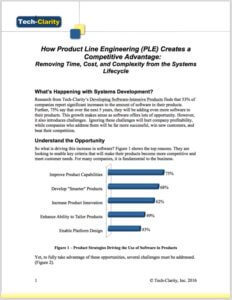 How Product Line Engineering (PLE) Creates a Competitive Advantage: Removing Time, Cost, and Complexity from the Systems Lifecycle discusses the growing importance of embedded software in today's products and the resulting complexity. The report highlights the negative impacts of not managing this complexity. Despite these impacts, there are benefits of using the right software. Those using the right software can better manage complexity. As a result, they see improvements in quality, efficiency, innovation, and development costs. The report explains this further. It also describes how Product Line Engineering (PLE) fits in and four things to look in a PLE solution.
Please enjoy the summary below.
For the full report, please visit our sponsor, BigLever (free of charge, registration required).
From this registration page, in addition to the report, you can also access an on-demand webinar on Product Line Engineering. During this webinar, you can learn more about the research from this report. You will also hear from Charles Krueger, CEO of BigLever Software.
How Product Line Engineering (PLE) Creates a Competitive Advantage: Removing Time, Cost, and Complexity from the Systems Lifecycle discusses the growing importance of embedded software in today's products and the resulting complexity. The report highlights the negative impacts of not managing this complexity. Despite these impacts, there are benefits of using the right software. Those using the right software can better manage complexity. As a result, they see improvements in quality, efficiency, innovation, and development costs. The report explains this further. It also describes how Product Line Engineering (PLE) fits in and four things to look in a PLE solution.
Please enjoy the summary below.
For the full report, please visit our sponsor, BigLever (free of charge, registration required).
From this registration page, in addition to the report, you can also access an on-demand webinar on Product Line Engineering. During this webinar, you can learn more about the research from this report. You will also hear from Charles Krueger, CEO of BigLever Software.
What’s Happening with Systems Development?
Research from Tech-Clarity’s Developing Software-Intensive Products finds that 53% of companies report significant increases to the amount of software in their products. Further, 75% say that over the next 5 years, they will be adding even more software to their products. This growth makes sense as software offers lots of opportunity. However, it also introduces challenges. Ignoring these challenges will hurt company profitability, while companies who address them will be far more successful, win new customers, and beat their competition.Key Takeaways
With the increasing amount of embedded software and the need to stand out from the competition, Product Line Engineering across systems and software can be a helpful way to enable platform design. With the right software solution, companies can avoid some of the challenges of systems engineering. Qualities to consider in a PLE solution include facilitating collaboration across engineering discipline, managing complexity, and supporting design automation. *This summary is an abbreviated version of the report and does not contain the full content. Use this link to download the full report. If you have difficulty obtaining a copy of the report, please contact us using the "Contact" link below. [post_title] => How Product Line Engineering (PLE) Creates a Competitive Advantage [post_excerpt] => [post_status] => publish [comment_status] => open [ping_status] => open [post_password] => [post_name] => product_line_engineering_ple [to_ping] => [pinged] => [post_modified] => 2022-11-14 22:27:51 [post_modified_gmt] => 2022-11-15 03:27:51 [post_content_filtered] => [post_parent] => 0 [guid] => http://tech-clarity.com/?p=5717 [menu_order] => 0 [post_type] => post [post_mime_type] => [comment_count] => 0 [filter] => raw ) [10] => WP_Post Object ( [ID] => 5702 [post_author] => 2 [post_date] => 2016-09-26 10:19:39 [post_date_gmt] => 2016-09-26 14:19:39 [post_content] => This short Tech-Clarity TV animation explains how manufacturers can get started with Product Data Management. The video offers findings from The Business Value of Product Data Management that finds that manufacturers can get off to a fast start with preconfigured solutions but still leave themselves room to grow on a foundation that provides more advanced capabilities. https://youtu.be/RN5996fXgXo This episode is sponsored by Siemens PLM. Learn more about Siemens PLM and their Teamcenter Rapid Start Program. [post_title] => Getting Started with PDM (animation) [post_excerpt] => [post_status] => publish [comment_status] => open [ping_status] => open [post_password] => [post_name] => plm-start [to_ping] => [pinged] => [post_modified] => 2022-12-02 15:06:52 [post_modified_gmt] => 2022-12-02 20:06:52 [post_content_filtered] => [post_parent] => 0 [guid] => http://tech-clarity.com/?p=5702 [menu_order] => 0 [post_type] => post [post_mime_type] => [comment_count] => 1 [filter] => raw ) [11] => WP_Post Object ( [ID] => 5684 [post_author] => 2572 [post_date] => 2016-09-20 09:16:36 [post_date_gmt] => 2016-09-20 13:16:36 [post_content] =>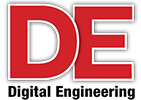 Hear Michelle Boucher share her recent research on Simulation Bottlenecks during a this webinar. Digital Engineering's Kenneth Wong will moderate this webinar sponsored by Siemens Femap.
This webinar will reveal:
Hear Michelle Boucher share her recent research on Simulation Bottlenecks during a this webinar. Digital Engineering's Kenneth Wong will moderate this webinar sponsored by Siemens Femap.
This webinar will reveal:
- The top improvement areas you should focus on to get even more value from simulation
- Best practices followed by Top Performing companies to overcome simulation bottlenecks
- Selection criteria to help you identify the right simulation solution for your company
 [post_title] => Addressing Bottlenecks in Simulation (webcast)
[post_excerpt] =>
[post_status] => publish
[comment_status] => open
[ping_status] => open
[post_password] =>
[post_name] => webinar-simulation-bottlenecks
[to_ping] =>
[pinged] =>
[post_modified] => 2022-11-14 22:26:52
[post_modified_gmt] => 2022-11-15 03:26:52
[post_content_filtered] =>
[post_parent] => 0
[guid] => http://tech-clarity.com/?p=5684
[menu_order] => 0
[post_type] => post
[post_mime_type] =>
[comment_count] => 0
[filter] => raw
)
[12] => WP_Post Object
(
[ID] => 5652
[post_author] => 2
[post_date] => 2016-09-19 09:13:57
[post_date_gmt] => 2016-09-19 13:13:57
[post_content] =>
[post_title] => Addressing Bottlenecks in Simulation (webcast)
[post_excerpt] =>
[post_status] => publish
[comment_status] => open
[ping_status] => open
[post_password] =>
[post_name] => webinar-simulation-bottlenecks
[to_ping] =>
[pinged] =>
[post_modified] => 2022-11-14 22:26:52
[post_modified_gmt] => 2022-11-15 03:26:52
[post_content_filtered] =>
[post_parent] => 0
[guid] => http://tech-clarity.com/?p=5684
[menu_order] => 0
[post_type] => post
[post_mime_type] =>
[comment_count] => 0
[filter] => raw
)
[12] => WP_Post Object
(
[ID] => 5652
[post_author] => 2
[post_date] => 2016-09-19 09:13:57
[post_date_gmt] => 2016-09-19 13:13:57
[post_content] =>  Jim Brown presented his recent research on building versus buying IIoT infrastructure in the upcoming Top 5 Factors for a Successful Industrial IoT Implementation webcast on Engineering.com (sponsored by Autodesk). The webcast also featured Autodesk's Head of IoT, Bryan Kester, sharing how IIoT can help improve product service, close the loop on engineering designs, and create new revenue streams.
Watch the Recorded Webcast. (free of charge, registration required)
Jim Brown presented his recent research on building versus buying IIoT infrastructure in the upcoming Top 5 Factors for a Successful Industrial IoT Implementation webcast on Engineering.com (sponsored by Autodesk). The webcast also featured Autodesk's Head of IoT, Bryan Kester, sharing how IIoT can help improve product service, close the loop on engineering designs, and create new revenue streams.
Watch the Recorded Webcast. (free of charge, registration required)
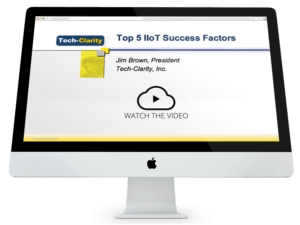 [post_title] => Top Five Five Factors for a Successful IIoT Implementation (webcast replay)
[post_excerpt] =>
[post_status] => publish
[comment_status] => open
[ping_status] => open
[post_password] =>
[post_name] => iiot-top5
[to_ping] =>
[pinged] =>
[post_modified] => 2022-11-14 22:26:44
[post_modified_gmt] => 2022-11-15 03:26:44
[post_content_filtered] =>
[post_parent] => 0
[guid] => http://tech-clarity.com/?p=5652
[menu_order] => 0
[post_type] => post
[post_mime_type] =>
[comment_count] => 0
[filter] => raw
)
[13] => WP_Post Object
(
[ID] => 5668
[post_author] => 2572
[post_date] => 2016-09-15 09:25:05
[post_date_gmt] => 2016-09-15 13:25:05
[post_content] => How Aerospace and Defense (A&D) Companies Get More Value from Simulation is a new Siemens guest post. In this post, Michelle Boucher explores how A&D companies use simulation. The post highlights challenges faced by A&D companies and then shares survey results revealing some of the top ways A&D solve them.
Read the post on the Siemens Femap Blog.
The results shared in this blog post came from our recent study, Addressing the Bottlenecks of FEA Simulation You can also hear more about this study at an upcoming webinar on Thursday, September 29, 2016 at 2:00 PM ET/ 11:00 AM PT.
[post_title] => Top Five Five Factors for a Successful IIoT Implementation (webcast replay)
[post_excerpt] =>
[post_status] => publish
[comment_status] => open
[ping_status] => open
[post_password] =>
[post_name] => iiot-top5
[to_ping] =>
[pinged] =>
[post_modified] => 2022-11-14 22:26:44
[post_modified_gmt] => 2022-11-15 03:26:44
[post_content_filtered] =>
[post_parent] => 0
[guid] => http://tech-clarity.com/?p=5652
[menu_order] => 0
[post_type] => post
[post_mime_type] =>
[comment_count] => 0
[filter] => raw
)
[13] => WP_Post Object
(
[ID] => 5668
[post_author] => 2572
[post_date] => 2016-09-15 09:25:05
[post_date_gmt] => 2016-09-15 13:25:05
[post_content] => How Aerospace and Defense (A&D) Companies Get More Value from Simulation is a new Siemens guest post. In this post, Michelle Boucher explores how A&D companies use simulation. The post highlights challenges faced by A&D companies and then shares survey results revealing some of the top ways A&D solve them.
Read the post on the Siemens Femap Blog.
The results shared in this blog post came from our recent study, Addressing the Bottlenecks of FEA Simulation You can also hear more about this study at an upcoming webinar on Thursday, September 29, 2016 at 2:00 PM ET/ 11:00 AM PT.
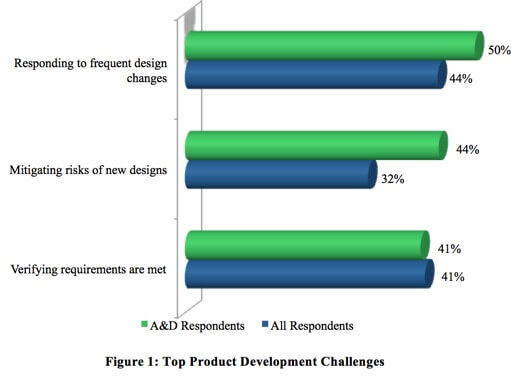
 [post_title] => How A&D Companies Get More Value from Simulation - Guest Post on Siemens Blog
[post_excerpt] =>
[post_status] => publish
[comment_status] => open
[ping_status] => open
[post_password] =>
[post_name] => aandd-simulation-siemens-guest-post
[to_ping] =>
[pinged] =>
[post_modified] => 2022-11-14 22:26:04
[post_modified_gmt] => 2022-11-15 03:26:04
[post_content_filtered] =>
[post_parent] => 0
[guid] => http://tech-clarity.com/?p=5668
[menu_order] => 0
[post_type] => post
[post_mime_type] =>
[comment_count] => 0
[filter] => raw
)
[14] => WP_Post Object
(
[ID] => 5658
[post_author] => 2
[post_date] => 2016-09-15 07:00:06
[post_date_gmt] => 2016-09-15 11:00:06
[post_content] =>
[post_title] => How A&D Companies Get More Value from Simulation - Guest Post on Siemens Blog
[post_excerpt] =>
[post_status] => publish
[comment_status] => open
[ping_status] => open
[post_password] =>
[post_name] => aandd-simulation-siemens-guest-post
[to_ping] =>
[pinged] =>
[post_modified] => 2022-11-14 22:26:04
[post_modified_gmt] => 2022-11-15 03:26:04
[post_content_filtered] =>
[post_parent] => 0
[guid] => http://tech-clarity.com/?p=5668
[menu_order] => 0
[post_type] => post
[post_mime_type] =>
[comment_count] => 0
[filter] => raw
)
[14] => WP_Post Object
(
[ID] => 5658
[post_author] => 2
[post_date] => 2016-09-15 07:00:06
[post_date_gmt] => 2016-09-15 11:00:06
[post_content] =>  Tech-Clarity's Jim Brown joined Arena Solutions' Ann McGuire on a TechBriefs webcast about avoiding product launch failures. Jim and Ann discussed why products fail and what companies are doing to improve product development success across the product lifecycle. The webcast, Avoid Product Launch Failure: Best Practices for Aligning Your Engineering and Quality Teams, is sponsored by Arena Solutions.
Watch the recorded event now (free of charge, registration required).
Tech-Clarity's Jim Brown joined Arena Solutions' Ann McGuire on a TechBriefs webcast about avoiding product launch failures. Jim and Ann discussed why products fail and what companies are doing to improve product development success across the product lifecycle. The webcast, Avoid Product Launch Failure: Best Practices for Aligning Your Engineering and Quality Teams, is sponsored by Arena Solutions.
Watch the recorded event now (free of charge, registration required).
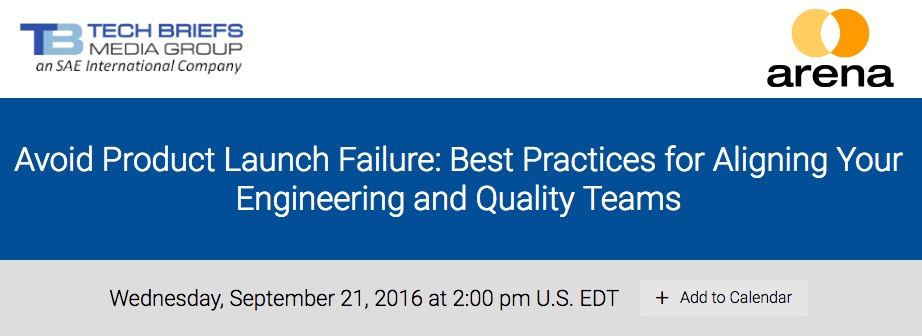 [post_title] => Avoid Product Launch Failure by Aligning Quality and Engineering (webcast replay)
[post_excerpt] =>
[post_status] => publish
[comment_status] => open
[ping_status] => open
[post_password] =>
[post_name] => npd-webcast
[to_ping] =>
[pinged] =>
[post_modified] => 2022-11-14 22:26:44
[post_modified_gmt] => 2022-11-15 03:26:44
[post_content_filtered] =>
[post_parent] => 0
[guid] => http://tech-clarity.com/?p=5658
[menu_order] => 0
[post_type] => post
[post_mime_type] =>
[comment_count] => 0
[filter] => raw
)
[15] => WP_Post Object
(
[ID] => 5632
[post_author] => 2
[post_date] => 2016-09-14 11:12:26
[post_date_gmt] => 2016-09-14 15:12:26
[post_content] => Jim Brown contributed his views on integrating Product Innovation Platforms / PLM to ERP in a recent guest post for Cideon Software. The post pays specific attention to how to integrate the 3DEXPERIENCE platform with SAP. The post shares the increasing importance of integration, the need for a repeatable approach, and some key considerations about finding a partner to help with the complexities of the integration.
Please read the full post on the Cideon Software site (free of charge, no registration required).
http://www.cideon.eu/3dx/best-practices/
[post_title] => Integrating Dassault Systemes' 3DEXPERIENCE Platform with SAP ERP (guest post)
[post_excerpt] =>
[post_status] => publish
[comment_status] => open
[ping_status] => open
[post_password] =>
[post_name] => 3dx-sap
[to_ping] =>
[pinged] =>
[post_modified] => 2022-11-14 22:25:32
[post_modified_gmt] => 2022-11-15 03:25:32
[post_content_filtered] =>
[post_parent] => 0
[guid] => http://tech-clarity.com/?p=5632
[menu_order] => 0
[post_type] => post
[post_mime_type] =>
[comment_count] => 1
[filter] => raw
)
[16] => WP_Post Object
(
[ID] => 5625
[post_author] => 2572
[post_date] => 2016-09-08 22:38:58
[post_date_gmt] => 2016-09-09 02:38:58
[post_content] => In a new Siemens guest post, What Is an Optimized Product Design? Michelle Boucher discusses how companies use simulation to optimize their products. However, the term optimization came be a bit vague as it means different things to different people. To clarify the term, this post shares additional data from our recent study, Addressing the Bottlenecks of FEA Simulation defining what engineers are actually trying to do when they optimize their designs.
Read the post on the Siemens Femap Blog.
[post_title] => Avoid Product Launch Failure by Aligning Quality and Engineering (webcast replay)
[post_excerpt] =>
[post_status] => publish
[comment_status] => open
[ping_status] => open
[post_password] =>
[post_name] => npd-webcast
[to_ping] =>
[pinged] =>
[post_modified] => 2022-11-14 22:26:44
[post_modified_gmt] => 2022-11-15 03:26:44
[post_content_filtered] =>
[post_parent] => 0
[guid] => http://tech-clarity.com/?p=5658
[menu_order] => 0
[post_type] => post
[post_mime_type] =>
[comment_count] => 0
[filter] => raw
)
[15] => WP_Post Object
(
[ID] => 5632
[post_author] => 2
[post_date] => 2016-09-14 11:12:26
[post_date_gmt] => 2016-09-14 15:12:26
[post_content] => Jim Brown contributed his views on integrating Product Innovation Platforms / PLM to ERP in a recent guest post for Cideon Software. The post pays specific attention to how to integrate the 3DEXPERIENCE platform with SAP. The post shares the increasing importance of integration, the need for a repeatable approach, and some key considerations about finding a partner to help with the complexities of the integration.
Please read the full post on the Cideon Software site (free of charge, no registration required).
http://www.cideon.eu/3dx/best-practices/
[post_title] => Integrating Dassault Systemes' 3DEXPERIENCE Platform with SAP ERP (guest post)
[post_excerpt] =>
[post_status] => publish
[comment_status] => open
[ping_status] => open
[post_password] =>
[post_name] => 3dx-sap
[to_ping] =>
[pinged] =>
[post_modified] => 2022-11-14 22:25:32
[post_modified_gmt] => 2022-11-15 03:25:32
[post_content_filtered] =>
[post_parent] => 0
[guid] => http://tech-clarity.com/?p=5632
[menu_order] => 0
[post_type] => post
[post_mime_type] =>
[comment_count] => 1
[filter] => raw
)
[16] => WP_Post Object
(
[ID] => 5625
[post_author] => 2572
[post_date] => 2016-09-08 22:38:58
[post_date_gmt] => 2016-09-09 02:38:58
[post_content] => In a new Siemens guest post, What Is an Optimized Product Design? Michelle Boucher discusses how companies use simulation to optimize their products. However, the term optimization came be a bit vague as it means different things to different people. To clarify the term, this post shares additional data from our recent study, Addressing the Bottlenecks of FEA Simulation defining what engineers are actually trying to do when they optimize their designs.
Read the post on the Siemens Femap Blog.
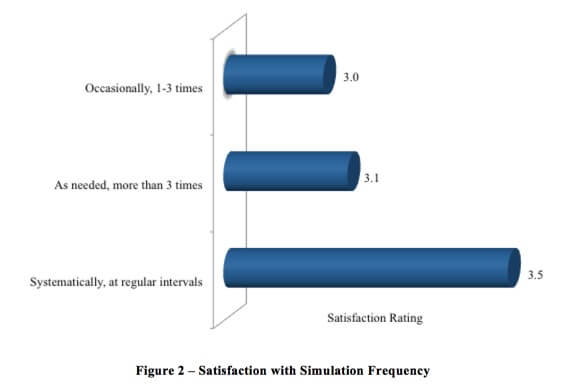
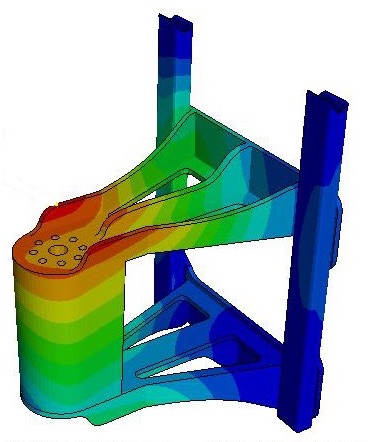
 Tech-Clarity's research report, Composites State of the Market: Using Composites as a Competitive Advantage, examines survey findings on material trends and composites. Over 240 companies participated in the survey. The research finds that new materials are a significant source of product complexity. The research also finds that of new materials, composites in particular, will see a lot of growth. However, there are engineering knowledge gaps when using composites. The report highlights how Top Performing companies supplement their engineering knowledge so that they can successfully develop and produce composite parts.
Please enjoy the summary below or click the report to download a PDF overview (free of charge, no registration required).
For more research on composites, check out our new survey for A&D companies.
For the full report, please visit our sponsor Siemens PLM (free of charge, no registration required).
Tech-Clarity's research report, Composites State of the Market: Using Composites as a Competitive Advantage, examines survey findings on material trends and composites. Over 240 companies participated in the survey. The research finds that new materials are a significant source of product complexity. The research also finds that of new materials, composites in particular, will see a lot of growth. However, there are engineering knowledge gaps when using composites. The report highlights how Top Performing companies supplement their engineering knowledge so that they can successfully develop and produce composite parts.
Please enjoy the summary below or click the report to download a PDF overview (free of charge, no registration required).
For more research on composites, check out our new survey for A&D companies.
For the full report, please visit our sponsor Siemens PLM (free of charge, no registration required).
Executive Overview
Today’s products are growing in complexity and new materials are a significant source of that complexity. Composites, in particular, are getting a lot of attention. In fact, the use of composites is growing and is expected to increase over the next 15 years. With this growth, the number of engineers working with composites should also increase by 15% over the next five years. Complicating this, even engineers currently working with composites rate their knowledge of composites as average. The combination of complexity, growth in composite use, and increase in the number of engineers using composites means companies will need better ways to supplement their engineering knowledge of composites. Composites have been key for helping many companies differentiate their products by reducing weight, improving performance, and lowering the cost of ownership. However, with the expense of composite material, companies must find ways to make better decisions to optimize the amount of composite material used to achieve performance requirements, without over-engineering and maintaining profitability. To understand best approaches, Tech-Clarity surveyed 244 companies to identify their goals for composites, best practices, and top selection criteria for technology. Further analysis identified how Top Performing companies address the top challenges of designing and producing composite parts. Top Performing companies are those who are more successful than their competitors. Compared to competitors, they are more efficient, faster, produce higher quality products, and do a better job meeting cost targets. When compared to peers, some of the things Top Performers do to achieve this success includes:- 2.2 times more likely to optimize the part design to improve consistency during production
- 59% more likely to use tools that automatically link design and analysis data
- 2.5 times more likely to use tools that automatically update the composite definition as changes are implemented
Table of Contents
- Executive Overview
- Identify the Meaning of Complexity
- Prepare for Growth in Composites
- Realize Opportunities with Composites
- Address Challenges
- Identifying Top Performers
- Understand Production Requirements
- Support Design Decisions
- Select the Right Technology
- Conclusion
- Recommendations
- About the Research
- About the Author
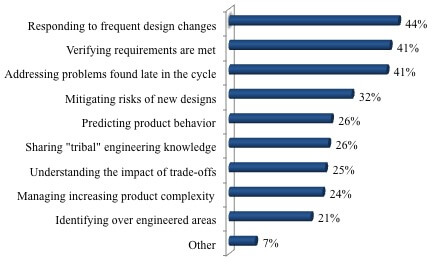
 [post_title] => How Simulation Solves Some of Today’s Top Product Development Challenges - Guest Post on Siemens Blog
[post_excerpt] =>
[post_status] => publish
[comment_status] => open
[ping_status] => open
[post_password] =>
[post_name] => simulation-solves-todays-top-product-development-challenges-guest-siemens-blog
[to_ping] =>
[pinged] =>
[post_modified] => 2022-11-14 22:26:01
[post_modified_gmt] => 2022-11-15 03:26:01
[post_content_filtered] =>
[post_parent] => 0
[guid] => http://tech-clarity.com/?p=5605
[menu_order] => 0
[post_type] => post
[post_mime_type] =>
[comment_count] => 0
[filter] => raw
)
)
[post_count] => 20
[current_post] => -1
[before_loop] => 1
[in_the_loop] =>
[post] => WP_Post Object
(
[ID] => 5874
[post_author] => 2
[post_date] => 2016-12-13 14:50:21
[post_date_gmt] => 2016-12-13 19:50:21
[post_content] =>
[post_title] => How Simulation Solves Some of Today’s Top Product Development Challenges - Guest Post on Siemens Blog
[post_excerpt] =>
[post_status] => publish
[comment_status] => open
[ping_status] => open
[post_password] =>
[post_name] => simulation-solves-todays-top-product-development-challenges-guest-siemens-blog
[to_ping] =>
[pinged] =>
[post_modified] => 2022-11-14 22:26:01
[post_modified_gmt] => 2022-11-15 03:26:01
[post_content_filtered] =>
[post_parent] => 0
[guid] => http://tech-clarity.com/?p=5605
[menu_order] => 0
[post_type] => post
[post_mime_type] =>
[comment_count] => 0
[filter] => raw
)
)
[post_count] => 20
[current_post] => -1
[before_loop] => 1
[in_the_loop] =>
[post] => WP_Post Object
(
[ID] => 5874
[post_author] => 2
[post_date] => 2016-12-13 14:50:21
[post_date_gmt] => 2016-12-13 19:50:21
[post_content] => 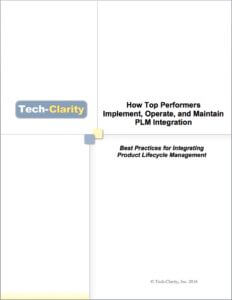 How Top Performers Implement, Operate, and Maintain PLM Integration - Best Practices for Integrating Product Lifecycle Management shares survey results detailing how Top Performers implement their PLM systems. The research uncovers integration challenges and best practices across the PLM Integration Lifecycle, recognizing that implementing integration is only the first step in the process.
Please enjoy the summary below, or click the report to download a PDF overview (free of charge, no registration required).
For the full report, please visit our sponsor, Razorleaf (free of charge, registration required).
How Top Performers Implement, Operate, and Maintain PLM Integration - Best Practices for Integrating Product Lifecycle Management shares survey results detailing how Top Performers implement their PLM systems. The research uncovers integration challenges and best practices across the PLM Integration Lifecycle, recognizing that implementing integration is only the first step in the process.
Please enjoy the summary below, or click the report to download a PDF overview (free of charge, no registration required).
For the full report, please visit our sponsor, Razorleaf (free of charge, registration required).
Table of Contents
 Executive Overview
Executive Overview- The Business Value of Integrating PLM
- When do Companies Begin Integrating?
- Introducing the PLM Integration Lifecycle
- Implementation Challenges
- Operation Challenges
- Maintenance Challenges
- Business Impacts
- Quantifying the Impact
- Identifying the Top Performers
- Top Performers Experience Fewer Negative Impacts
- Top Performers Integrate More
- Top Performers Integrate with More Advanced Tools
- Top Performers Integrate with More Advanced Enterprise Applications
- Top Performers Integrate More PLM Data
- Top Performers Use More Advanced Integration Techniques
- Focusing on the Future: The Impact of IoT on PLM Integration
- Conclusion
- Recommendations
- About the Author
- About the Research
- Copyright Notice
Executive Overview
Product Lifecycle Management (PLM) helps manufacturers in many ways ranging from operational efficiencies to top-line financial improvement. It improves business performance in multiple dimensions including increased revenue, reduced product cost, and decreased product development cost. But PLM is just one of many systems in the engineering and enterprise software ecosystems, and provides greater value when it shares data and connects workflows with other software. As reported in Product Lifecycle Management Beyond Managing CAD, “Top Performers are much more likely to integrate PLM with a host of other systems.” We surveyed over 150 companies to understand their PLM integration strategy, processes, and technical enablers in order to understand how proper integration can extend PLM value. The findings indicate that the vast majority of manufacturers view PLM as “Strategic” or “Important.” It also finds that many believe that PLM integration will become even more strategic (and challenging) as IoT initiatives progress. In order to understand how companies get the most business value from PLM integration, we identified manufacturers that were gaining the largest operational benefit from their PLM implementation, the Top Performers. These leaders achieve significantly better than average PLM business benefits. We analyzed what these companies do differently related to PLM integration in order to offer advice to poorer performing companies. The analysis determines that Top Performers in gaining the benefits from PLM: Are more likely to view PLM integration as strategic
Are more likely to view PLM integration as strategic- Integrate PLM to more design tools and more enterprise applications
- Integrate PLM to more advanced tools and applications
- Are more able to implement, operate, and maintain PLM integration in an agile, cost-effective way
- Experience fewer operational issues including:
- Needing to look for data in multiple systems
- Duplicate data entry
- Data inconsistency across systems
Conclusion
PLM helps companies improve product innovation, product development, and engineering efficiency and helps enhance communication across the enterprise and the supply chain. Improving PLM integration helps companies achieve the benefits PLM has to offer, making it a highly strategic investment. The level of importance, along with the level of complexity, will only increase as companies move to smarter, more connected products and the IoT. Top Performers, those that get the most benefits out of their PLM systems, are more likely to view PLM integration as strategic. They integrate more design tools and enterprise applications with PLM, and integrate PLM to more advanced tools and applications. They also integrate more data, including more information that spans the enterprise and the supply chain. The leads us to the conclusion that better PLM integration is simply good business. Top Performers take different approaches to integrating PLM, employing a variety of tools but more likely including adaptable techniques like a hub and spoke approach that provides benefits across the PLM Integration Lifecycle. The result is that these Top Performing companies are more able to implement, operate, and maintain PLM integration in an agile, cost-effective way and experience less need to look for data in multiple systems, perform less duplicate data entry, and find less data inconsistency across systems.Recommendations
Based on our experience and the research for this report, Tech-Clarity offers the following recommendations:- Manufacturers should integrate PLM with a broader number of enterprise applications and design tools
- Companies should integrate with more advanced systems, including those that extend beyond Engineering into the enterprise and the supply chain
- Companies should use a variety of integration techniques depending on the specific solutions and connectivity methods available, leveraging more advanced approaches such as hub and spoke when practical to provide more agility across the PLM Integration Lifecycle
- Manufacturers should consider outside expertise to fill the PLM integration knowledge gap
- Companies should focus integration plans and efforts beyond the initial implementation to optimize across the entire PLM Integration Lifecycle
All Results for "All"
Five Ways to Beat Product Development Deadlines (webcast)
Jim Brown will present findings from his recent study on New Product Development and Introduction (NPDI) to help companies learn from Top Performing product developers. The webcast will share the strategies, approaches, and enablers they use to drive high profits from their new product initiatives. Learn how the leaders will meet (or beat) their new…
Better PLM Integration Drives Better Business Performance (Webcast)
Tech-Clarity analyst Jim Brown joins Razorleaf’s Director of Integrations and Development Derek Neiding to share the results of a recent study on PLM integration. The webcast will highlight the strategies, processes, and technologies Top Performers use to integrate PLM with design tools and other enterprise systems. Register now for the December 13 webcast, sponsored by Razorleaf Corporation (free…
Engineering Live PLM Discussion
Join an interactive discussion between Tech-Clarity’s Jim Brown and Autodesk’s Ron Locklin moderated by Advantage Business Media Editor in Chief Janine Mooney as they discuss the history, challenges, benefits, and future of Product Lifecycle Management (PLM). The event will be available on Product Design & Development, Manufacturing.net, and Manufacturing Business Technology. Watch the event live, October 31 at…
Moving Production Innovation and Engineering to the Cloud (guest blog post)
Jim Brown contributed insights from his recent research on cloud options for product innovation, product development, and engineering software in a guest post titled Moving Production Innovation and Engineering to the Cloud, What’s Your Strategy? on the Siemens PLM Community. The post references findings our recent Exploring Cloud Options for Product Innovation and Development eBook. For more information on…
Successful Products Start and End with Your Customer (infographic)
Tech-Clarity’s Infographic, Successful Products Start and End with Your Customer provides guidance to CPG companies. By embedding your customer in the middle of your product life cycle, your products will be more successful. The infographic, shows that by capturing insights obtained during the shopping experience, you can drive a move successful approach to product development. To be…
Cloud Options for Product Innovation and Development (eBook)
The Exploring Cloud Options for Product Innovation and Development eBook shares our thoughts about the cloud software choices available for product innovation, product development, and engineering software including PLM, PDM, CAD, CAE, and more. The eBook details the different software models available and provides considerations for each. It also helps put the various options into context with a…
New Possibilities with IoT – Contribution to PTC eBook
To help manufacturers prepare for the future of product design, PTC has released a new eBook, 10 Expert Insights : The Future of Product Design in the Age of Smart & Connected Devices. Michelle Boucher’s contribution, New Possibilities with IoT, shares her thoughts on the future of product design. In this section, she explains how the Internet of Things will empower product…
Top Five Factors for a Successful IIoT Implementation (guest post)
Jim Brown contributed a post to the Autodesk Fusion Connect site sharing the Top Five Factors for a Successful Industrial IoT Implementation. The post provides an introduction to our Ten Build-Buy Factors for IoT Platforms eBook tailored to Engineers so they can understand not only how to support their company’s IoT initiative, but also how to gain…
How Product Line Engineering (PLE) Creates a Competitive Advantage
How Product Line Engineering (PLE) Creates a Competitive Advantage: Removing Time, Cost, and Complexity from the Systems Lifecycle discusses the growing importance of embedded software in today’s products and the resulting complexity. The report highlights the negative impacts of not managing this complexity. Despite these impacts, there are benefits of using the right software. Those using the right…
Getting Started with PDM (animation)
This short Tech-Clarity TV animation explains how manufacturers can get started with Product Data Management. The video offers findings from The Business Value of Product Data Management that finds that manufacturers can get off to a fast start with preconfigured solutions but still leave themselves room to grow on a foundation that provides more advanced capabilities. This episode is sponsored by Siemens PLM. Learn…
Addressing Bottlenecks in Simulation (webcast)
Hear Michelle Boucher share her recent research on Simulation Bottlenecks during a this webinar. Digital Engineering’s Kenneth Wong will moderate this webinar sponsored by Siemens Femap. This webinar will reveal: The top improvement areas you should focus on to get even more value from simulation Best practices followed by Top Performing companies to overcome simulation bottlenecks Selection criteria to help…
Top Five Five Factors for a Successful IIoT Implementation (webcast replay)
Jim Brown presented his recent research on building versus buying IIoT infrastructure in the upcoming Top 5 Factors for a Successful Industrial IoT Implementation webcast on Engineering.com (sponsored by Autodesk). The webcast also featured Autodesk’s Head of IoT, Bryan Kester, sharing how IIoT can help improve product service, close the loop on engineering designs, and…
How A&D Companies Get More Value from Simulation – Guest Post on Siemens Blog
How Aerospace and Defense (A&D) Companies Get More Value from Simulation is a new Siemens guest post. In this post, Michelle Boucher explores how A&D companies use simulation. The post highlights challenges faced by A&D companies and then shares survey results revealing some of the top ways A&D solve them. Read the post on the…
Avoid Product Launch Failure by Aligning Quality and Engineering (webcast replay)
Tech-Clarity’s Jim Brown joined Arena Solutions’ Ann McGuire on a TechBriefs webcast about avoiding product launch failures. Jim and Ann discussed why products fail and what companies are doing to improve product development success across the product lifecycle. The webcast, Avoid Product Launch Failure: Best Practices for Aligning Your Engineering and Quality Teams, is sponsored by Arena…
Integrating Dassault Systemes’ 3DEXPERIENCE Platform with SAP ERP (guest post)
Jim Brown contributed his views on integrating Product Innovation Platforms / PLM to ERP in a recent guest post for Cideon Software. The post pays specific attention to how to integrate the 3DEXPERIENCE platform with SAP. The post shares the increasing importance of integration, the need for a repeatable approach, and some key considerations about finding a partner…
What Is an Optimized Product Design? – Guest Post on Siemens Blog
In a new Siemens guest post, What Is an Optimized Product Design? Michelle Boucher discusses how companies use simulation to optimize their products. However, the term optimization came be a bit vague as it means different things to different people. To clarify the term, this post shares additional data from our recent study, Addressing the Bottlenecks of FEA…
How Should You Use Simulation? – Guest Post on Siemens Blog
Michelle Boucher shares additional findings from our recent study, Addressing the Bottlenecks of FEA Simulation in this Siemens guest post, How Should You Use Simulation. This guest post discusses some of the the top ways Top Performing companies apply simulation during product development. The post shares additional survey data on the benefits Top Performers report as a result of using simulation….
Composite State of the Market (Survey Findings)
Tech-Clarity’s research report, Composites State of the Market: Using Composites as a Competitive Advantage, examines survey findings on material trends and composites. Over 240 companies participated in the survey. The research finds that new materials are a significant source of product complexity. The research also finds that of new materials, composites in particular, will see a…
How Simulation Solves Some of Today’s Top Product Development Challenges – Guest Post on Siemens Blog
In this Siemens guest post, How Simulation Solves Some of Today’s Top Product Development Challenges Michelle Boucher shares additional findings from our recent study, Addressing the Bottlenecks of FEA Simulation. This guest post shares some of the top development challenges companies struggle with and then shares some of the ways Top Performing companies address these challenges. Simulation is…
